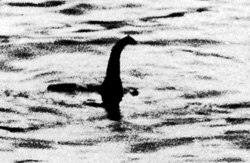Loch Ness Lake Monster

Loch Ness Monster (Fg. 10-10)
Of all the cryptids believed to exist around the world, Nessie is one of the most sensationalized by media coverage and speculation. Many people know the story of Ness and have entertained themselves with the concept of an supposedly extinct dinosaur swimming in the depths of a Scottish lake. Controversial photographs and eyewitness accounts helped Loch Ness gain attention while portraying an astounding question asking whether or not dinosaurs could still exist.
The Surgeon's photo, in particular, depicts a shadowy figure estimated to be located around 4 km from the camera. Incredibly, this figure strangely resembles a type of plesiosaur considered only to be part of fossil record. Multiple theories have attempted to debunk Nessie, ranging from a bobbing tree trunk to optical illusions and intentional hoaxes. Despite skepticism, many eyewitness testimonies have stood up to the onslaught and continue to spark the imagination of folks wondering what really might live deep below Loch Ness.
Hundreds of years ago, Scotland's Lochs were home to a Christian revolution, as Evangelist, Saint Columba traveled north toward Pictland in a mass effort to reform local belief systems. He was very successful and gained quite a popular adoration by in part to Adoman, the 9th Abbot of Iona, who documented Columba's travels in prideful detail. Adoman worked to exemplify feats of Columba by recording many miracle events, one of which some believe might indicate Columba encountered Nessie for the first time in history, late in the 6th century. Adoman's account describes Saint Columba running into men burying a body previously attacked by a water monster called Niseag.
Given there is sufficient archaeological evidence to say both creatures went extinct millions of years ago, and the unlikeliness of either animal surviving undetected until a couple thousand years ago, it seems as though Nessie is not a lone dinosaur. This is science's take on it, requiring biological evidence of either dinosaur to prove otherwise, and to their credit, Loch Ness itself was formed around 10,000 years ago by a receding glacier. If Nessie is a Plesiosuchus, Plesiosaur, or related dinosaur from millions of years ago, then likely she had to move into the Loch after its creation. Life without doubt is full of strange enough phenomena.
Maybe Niseag could be one of those rare animals who survived in the deep ocean despite science claiming the improbable. The world's ocean system is vast and plenty large enough to sustain a breeding population of dinosaurs who managed to survive a catastrophic extinction event 65 million years ago. In fact, many ocean dwelling creatures may have been protected during the initial fallout long enough for food chain cycles to replenish, and it wouldn't be out of the ordinary for life to flourish through catastrophe once again.
There is perhaps yet another angle to help explain Nessie. By constructing certain elements of local folklore we discover characteristics of a beast which might be responsible for stimulating Nessie sightings. Starting with the name, Ness - Loosely translates to a cape, promontory, headland, fore-land, Naze (Eastern England Headland), or head. Niseag, as referred to by Saint Columba, is a Scottish Gaelic female name for Little Ness. Possibly a significant clue here - Little head. Many eyewitness accounts and photographs describe a creature with a smaller head at the end of what could be described as a long neck. Hence a suggested identification of a plesiosaur even though we know these dinosaurs had to overcome tremendous odds to be placed in Loch Ness by the 20th century. Known species in Scottish lakes don't fit Ness descriptions very well, but what if perhaps a known species from another location moved into Scottish territory, using the lochs as safe haven due to increased human population in the previous area?
† Article 10-10
